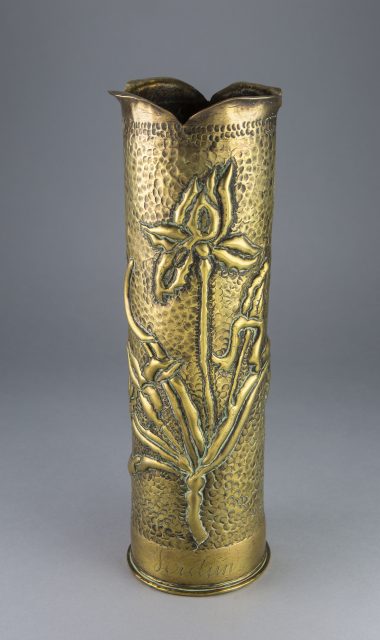Fall 2017
For Home and Country
Louisiana State Museum's new exhibition in Baton Rouge looks at Louisiana during and after WWI.
Published: September 22, 2017
Last Updated: October 18, 2018
At the time, the “war to end all wars” was among the most destructive and disruptive conflicts the world had ever known. It marked the first widespread use of poisonous gas, airplanes, and tanks on the battlefield and it transformed global politics for many years to come. After remaining neutral for almost three years, the United States formally entered World War I on April 6, 1917, aligning itself with France, Great Britain, Russia, and Belgium in their struggle against Germany and Austria-Hungary. Louisianans, like other Americans, answered the call to action almost immediately. Military training facilities quickly sprang up around the state including Camp Nicholls and Camp Martin in New Orleans, Camp Beauregard near Alexandria, and Gerstner Field near Lake Charles. Men were asked, and later compelled, to join the military, accompanied by more than one hundred Louisiana women who enlisted in the US Navy. Many of those unable to serve worked fundraising for the war effort, often by promoting Liberty Loan drives.

Registrar Elizabeth Sherwood cleans a Hotchkiss Mle 1900, a machine gun used in World War I. Courtesy of Louisiana State Museum. Photo by Mark J. Sindler.
To document Louisianans’ war experiences, For Home and Country will include more than one hundred artifacts and images from the Louisiana State Museum’s extensive collection of World War I materials. Many of these materials were donated by the French Republic as an expression of their gratitude for America’s participation in the war. Arriving in New Orleans August 10, 1920, the donation filled three train cars and included uniforms, machine guns, gas masks, grenades, and a Renault FT-17 tank, among other things. The collection expanded considerably throughout the twentieth century as veterans and their families donated war-related objects to the museum.
For the exhibition, artifacts and images from this collection will be organized into four sections: Homefront, Mobilization, Warfront, and Memorialization. The Homefront section explores how Louisianans, in the armed forces and out, were affected by the conflict overseas. Artifacts features in this area will include several war-related posters, patriotic sheet music, and a gold star flag. These flags were given to families who lost a son in battle.
The Mobilization area highlights the state’s efforts to recruit and train soldiers as well as the struggles of Louisiana businesses to outfit them with necessary supplies. In addition to military recruitment posters, training materials, and a William Woodward painting of General Allison Owen, this section will include a handful of items from Storyville, a New Orleans red-light district created to regulate prostitution. Established in 1897, Storyville was shut down in November 1917—under pressure from then Secretary of the Navy Josephus Daniels—since the district was deemed a threat to the health and morals of the armed forces.

The word “Verdun” appears on the bottom of this decorated 1917 brass shell casing suggesting that it is somehow linked to the Battle of Verdun, the longest battle of the First World War. Courtesy of the Louisiana State Museum. Photo by Mark J. Sindler.
The Warfront section focuses on Louisianans who fought in the trenches and on the battlefields of Europe, as well as the medical and administrative workers who supported them. Items on display include a Mauser Tankgewehr M1918—the first anti-tank rifle—and a French ration coupon issued to Captain Moise Conrad from West Feliciana Parish. A pair of high-top leather boots worn by New Orleans native and physician Dr. Louis Genella will also appear. Genella, who fought with the British Expeditionary Force in France in the summer of 1917, was among the first American soldiers injured in the war. In addition, the exhibition will feature the uniforms of renowned Tulane surgeon Rudolph Matas, developer of the intravenous drip technique, and T. Semmes Walmsley, who went on to become mayor of New Orleans and a critic of Governor Huey P. Long
Finally, the Memorialization area explores how Louisianans commemorated the war’s end, memorialized the loss of family and friends, and coped with its long-term effects. Artifacts on display include a souvenir pillow, military-inspired toys, and a program from a luncheon honoring of Marshal Ferdinand Foch, the French supreme commander of the Allied forces, who visited New Orleans in December 1921. Photographs of Louisiana war memorials will be displayed, including Victory Park in Baton Rouge and the Victory Arch in New Orleans’s Macarty Square.
For Home and Country: Louisiana in the Great War will remain on display through June 2018.

